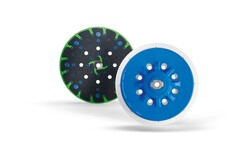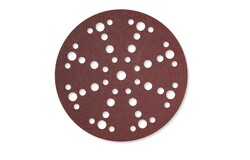Whether in the workshop, on the construction site or at home: The Festool App is your companion for smart working and perfect results.

Sanding furniture surfaces and edges: Our professional tips for you
For quick and easy sanding of surfaces and edges:
We'll help you choose the tools and matching accessories that are ideal for you, as well as helpful application tips so you can achieve perfect results when sanding furniture. Festool has a long tradition of sanding. We have therefore continued to develop the whole sanding system. From the machine to the sanding pad and abrasive through to the mobile dust extractor, everything fits perfectly together.
Sanding surfaces and edges: Now's the time to make your selection!
Here you can find all information about the individual products, accessories and consumables.
The RUBIN 2 abrasive is ideally suitable in grit sizes P80, P120, P150 and P180 up to surface processing (application of paint or oil). The recommended grit grade and spacings for the abrasive are suggestions only and not specifications. We recommend not selecting large spacings between the different grit sizes. As a general rule, the grit size selection depends on the desired sanding result. The higher the grit number, the finer the surface result.
Festool video
Current Festool TV episodes and tips from our application experts:
It's so simple: A step-by-step guide for every application.
Here you can find our detailed application examples for sanding surfaces and edges.
-

Intermediate sanding for furniture surfaces
Intermediate sanding of painted furniture components is necessary before applying the next paint layer. This is often done by hand with a sanding block, but this can lead to problems. In this application example, we'll explain how to achieve a quicker result with the Festool sanding system, as well as how significantly less dust is produced when doing so. See the application example -

Sanding perpendicular joints
When two pieces of wood meet at right angles, particular care needs to be taken to avoid sanding across the grain of the wood, as otherwise the surface could become damaged and scratched. This application example shows a practical solution with the eccentric sander, for sanding frames with mitre joints, for example, or even butt-jointed frames. See the application example -

Choose the right abrasive
Whether you are removing old coats of paint from furniture, chamfering edges, renovating worn wooden flooring, sanding wood, carrying out intermediate sanding, sanding filler compounds or simply removing coatings – using abrasives is vital when it comes to achieving the perfect precision fit or surface quality. In this application example, we explain which abrasive is suitable for which application. See the application example
How do you achieve a perfect sanding result? The best way is to use a system.
In no other area is the system concept as evident as the development of our sanding tools. Robust, ergonomic tools that were designed to be used effortlessly for long periods. With individually adapted pads and abrasive sheets for transferring force perfectly and abrasives developed with the same care as the tools themselves.
-

The sanding tools
Depending on the surface quality and desired result, different sanding motions can be selected for coarse and fine sanding. We have therefore developed the right sanders, which perfectly fit into the sanding system. View sanders -

The sanding pad system
Sanding pads suitable for every type of application are available in different degrees of hardness ranging from ultra-soft to hard. Can be changed quickly and, because of the Jetstream principle or MULTI-JETSTREAM 2 (for D 150), have efficient extraction and produce little heat. View MULTI-JETSTREAM 2 -

The extraction system
The air stays free of dust if a good dust extraction system is used. All of this provides highly consistent work results and prevents sanding dust from getting in your lungs. View extraction system
RUBIN 2 abrasive
The RUBIN 2 abrasive has been specially developed for solid wood and wood materials. It is suitable for coarse sanding work, such as smoothing planing blemishes and sanding off protrusions. What's more, it can be used for final fine sanding for subsequent oiling, waxing or painting procedures.
GRANAT abrasive
Perfect for intermediate sanding for surface treatment. GRANAT premium abrasive with its fine grit size is absolutely ideal. Let's see why:
Manual abrasive is always a good choice!
Whether you need to work in hard-to-reach places or perform small correction tasks, the long-lasting and strong manual abrasives are ideal for any instance of manual sanding.

Sanding ≠ sanding
What are the important points to bear in mind for sanding?






























































